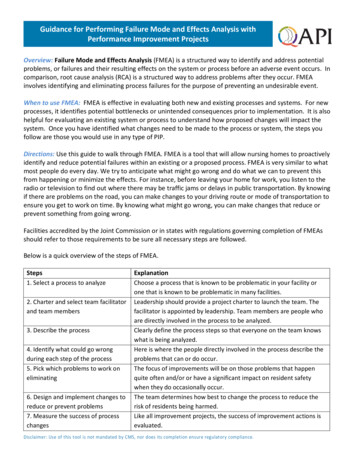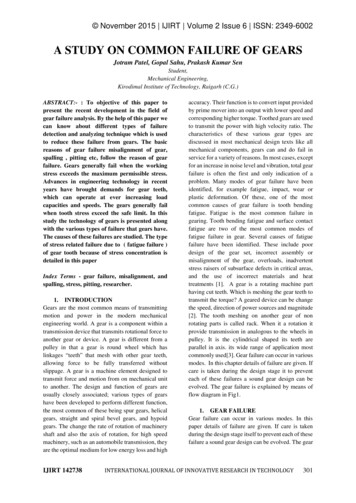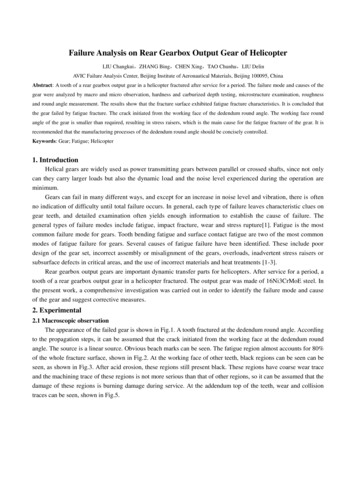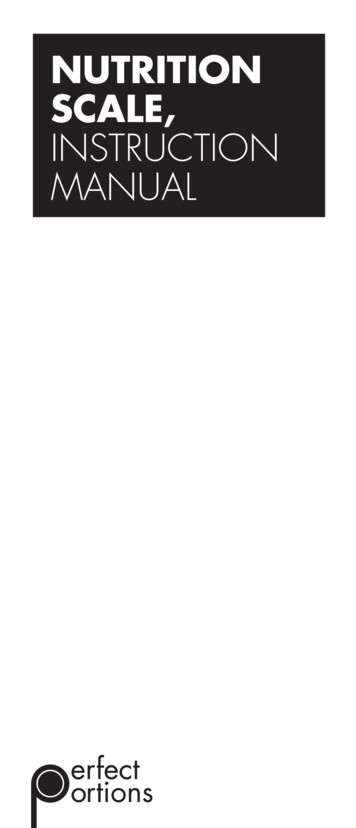
Transcription
Guidance for Performing Failure Mode and Effects Analysis withPerformance Improvement ProjectsOverview: Failure Mode and Effects Analysis (FMEA) is a structured way to identify and address potentialproblems, or failures and their resulting effects on the system or process before an adverse event occurs. Incomparison, root cause analysis (RCA) is a structured way to address problems after they occur. FMEAinvolves identifying and eliminating process failures for the purpose of preventing an undesirable event.When to use FMEA: FMEA is effective in evaluating both new and existing processes and systems. For newprocesses, it identifies potential bottlenecks or unintended consequences prior to implementation. It is alsohelpful for evaluating an existing system or process to understand how proposed changes will impact thesystem. Once you have identified what changes need to be made to the process or system, the steps youfollow are those you would use in any type of PIP.Directions: Use this guide to walk through FMEA. FMEA is a tool that will allow nursing homes to proactivelyidentify and reduce potential failures within an existing or a proposed process. FMEA is very similar to whatmost people do every day. We try to anticipate what might go wrong and do what we can to prevent thisfrom happening or minimize the effects. For instance, before leaving your home for work, you listen to theradio or television to find out where there may be traffic jams or delays in public transportation. By knowingif there are problems on the road, you can make changes to your driving route or mode of transportation toensure you get to work on time. By knowing what might go wrong, you can make changes that reduce orprevent something from going wrong.Facilities accredited by the Joint Commission or in states with regulations governing completion of FMEAsshould refer to those requirements to be sure all necessary steps are followed.Below is a quick overview of the steps of FMEA.Steps1. Select a process to analyze2. Charter and select team facilitatorand team members3. Describe the process4. Identify what could go wrongduring each step of the process5. Pick which problems to work oneliminating6. Design and implement changes toreduce or prevent problems7. Measure the success of processchangesExplanationChoose a process that is known to be problematic in your facility orone that is known to be problematic in many facilities.Leadership should provide a project charter to launch the team. Thefacilitator is appointed by leadership. Team members are people whoare directly involved in the process to be analyzed.Clearly define the process steps so that everyone on the team knowswhat is being analyzed.Here is where the people directly involved in the process describe theproblems that can or do occur.The focus of improvements will be on those problems that happenquite often and/or or have a significant impact on resident safetywhen they do occasionally occur.The team determines how best to change the process to reduce therisk of residents being harmed.Like all improvement projects, the success of improvement actions isevaluated.Disclaimer: Use of this tool is not mandated by CMS, nor does its completion ensure regulatory compliance.
Step 1: Select a process to analyzeNursing homes are complex organizations and involve processes in many areas, such as resident care,business operations, environmental services, and others. You can use FMEA to examine processes in any ofthese areas to proactively reduce risks to patient safety and improve quality of care and quality of life forresidents.When conducting FMEA on an existing process, consider selecting a process that is known to be problemprone or potentially risky. For instance, do staff members consistently perform skin assessments promptlyafter admission? FMEA can be used to identify gaps and develop actions to make the process more efficientand safe. FMEA also helps to prepare for implementation of new processes. Are you concerned about howyou will implement electronic health records? FMEA promotes systematic thinking in terms of “Whatchallenges will we encounter? What can we do to meet these challenges?Ask your employees what activities or processes have not yet provided the desired result. They may tell youthere is a safety concern related to monitoring cognitively impaired individuals who like to wander. You cando FMEA on your process for regularly assessing these residents and protecting those found to be vulnerablefor injury or elopement. Helpful Tips:o Be sure an identifiable process is chosen for FMEA. Instead of, “We will do FMEA on theproblem of unexplained weight loss among some residents,” consider doing FMEA on theprocess used in your facility to prevent residents from having an unexplained weight loss.Unexplained weight loss is an outcome, not a process. A process is a series of actions or stepstaken to achieve an end.o Narrow the scope of FMEA as much as possible. For instance, when facilities try to do a projecton a complex process such as medication administration the team often finds there are toomany variables to take into account. The administration process can vary by unit, by type ofmedication, by time of day, and so on. It is best to narrow the focus. For instance, do FMEA onadministration of a particular type of high-risk medication or a project on medicationadministration for a category of residents vulnerable to safety problems.o To get employees to support FMEA and make necessary process changes, senior managementshould consult staff members about processes they believe are challenging.o Consider using FMEA to evaluate new processes. It is a good technique for anticipating whatcould happen so processes can be made safer before full implementation.Disclaimer: Use of this tool is not mandated by CMS, nor does its completion ensure regulatory compliance.
Step 2: Select people for the teamOnce it is decided that a Performance Improvement Project (PIP) will be conducted on a process using FMEA,leadership should begin by designating a facilitator for this team. Together they should create a charter thatwill help guide the team in managing the scope of the project and ensure the implemented changes reflectthe FMEA findings. They should also work together in selecting staff to participate on the PIP team.The facilitator is often someone already involved in QAPI in the facility. As managers, supervisors, and staffmembers gain experience in doing FMEA, more people in the facility can be trained to serve as FMEAfacilitators.The direct care staff selected to serve as team members should have day-to-day responsibilities forcompleting one or more steps in the process under analysis. A personal knowledge of what actually happens,not what should happen, is vital to the project success.The number of people on a team depends on the scope of the process review. There should be at least onerepresentative from each employee group involved in the process. For instance, if the project is aimed at theprocess of assessing residents for fall risk and protecting those found to be high risk, the team should includerepresentatives from nursing (RN or LPN), direct care staff (nurse assistant or CNA), housekeeping, andphysical therapy. Consider physician involvement when the process includes steps that involve physicians. Helpful Tips:o Minimize the number of management or supervisory level individuals on the team. Staffmembers may be inhibited from speaking up during critical discussions about processproblems if their direct supervisor is in the room.o Involve direct care staff and those who have direct experience with the process beinganalyzed. It is important to understand the process as it is actually performed, including whystaff make mistakes and develop work-a-rounds.o Include people from all shifts on the team, when possible. The experiences of staff workingduring the day may be much different than what happens during the evening and night shift. Asuccessful FMEA is highly dependent on the ability of the team members to understand how aprocess now functions and what occasionally goes wrong.o It can sometimes be tempting to complete FMEA by interviewing those involved in theprocess, without any formal meetings of the team. While this might move the analyses alongquicker, the frank discussions that occur during team meetings are more likely to lead to asuccessful FMEA – one that actually improves the safety of a high-risk resident care process.Disclaimer: Use of this tool is not mandated by CMS, nor does its completion ensure regulatory compliance.
Step 3: Describe the processAt the first meeting, the team clearly defines the process to be analyzed. The best way to do this is toconstruct a flowchart of the steps. (See the QAPI Flowchart Guide for more information on creatingflowcharts) Using sticky notes, write down the first step in the process and each subsequent step. Theprocess description does not need to be detailed. A high-level flowchart, with just the major steps identified,is usually sufficient.The example below shows the steps in the process of starting Coumadin for residents not currently on thisanticoagulant. The process starts with the physician ordering Coumadin for a resident and ends with ongoingmonitoring of the patient’s INR (a measure of blood coagulation) and clinical status.Physician initiatesCoumadin therapyfor a residentCoumadinadministrationbeginsMonitor resident’sinitial response toCoumadinContinue givingCoumadin andadjust dose toreach target INRContinue givingCoumadin andmonitor tomaintain targetINRStarting with a clear description of the process ensures that everyone on the team understands what is beinganalyzed. Once the team members agree that the process is clearly and accurately described, move to step 4.If there is confusion about the actual process steps or if people cannot agree on what the process entails, donot continue on to step 4 of the FMEA. It may be necessary to refine the scope of the FMEA. For instance,one nursing home started FMEA on the process of admitting new residents. While describing the process,team members found that admission steps varied somewhat on the weekends. They chose to concentratetheir analysis on the weekend admission process because it seemed to be the most problem-prone. Theyagreed to later do FMEA on weekday admissions. Helpful Tips:o If team members cannot agree on how the process currently works in their area and theprocess scope cannot be narrowed to obtain agreement, it usually is a signal of a veryunreliable process. An unreliable process is one that is not performed consistently – peoplepretty much do whatever works best for them. FMEA should not be done on this process;instead, do a performance improvement project that is aimed at creating a redesignedstandard streamlined process. Once that new process is designed, consider doing FMEA toreduce or eliminate mistakes that may occasionally occur.o For a complex process with many steps, it may be better to do several FMEAs by breaking-upthe process into manageable bites. By focusing on just one part of the process, the team cancomplete the FMEA in much shorter time. For instance, there are several major steps to theprocess of identifying residents at high risk for falls and preventing falls in this group ofresidents. The team could do FMEA just on the assessment phase of the process and anotheron the prevention phase.Disclaimer: Use of this tool is not mandated by CMS, nor does its completion ensure regulatory compliance.
Step 4: Identify what could go wrong during each step of the processHere is where the knowledge and experience of team members are vital. For each process step identified instep 3, the team determines what can go wrong or what can fail (commonly called the failure modes). Thepeople doing the work every day are in the best position to know what can (and does) go wrong.This step is similar to a brainstorming session where people generate ideas and come up with solutions toproblems. At this point, team members are generating a list of the failures that can occur at each step of theprocess being analyzed. Below are examples of things that could go wrong during the step of “Physicianinitiates Coumadin therapy for a resident.”Physician initiatesCoumadin therapyfor a residentWhat Could Go Wrong (failure modes)1. Order not entered into computer2. Order not communicated toPharmacy3. Wrong dosage ordered4. Physician unaware Coumadin iscontraindicated for this residentAfter the possible failures are identified for one step, the team moves on to identifying failures that mightoccur in the next step. Step 4 is complete when the team is satisfied all possible failures have been identifiedfor each step. Helpful Tips:o Create an atmosphere where staff participating in the FMEA feel safe talking about processmistakes, or work-arounds that occur. To decrease “protectionism” where staff are reluctantto talk about mistakes made by the peer group they represent, make it clear from thebeginning that everyone sometimes makes a mistake and it is not a sign of incompetence;rather most mistakes are the result of a poorly designed process.o Do not let this brainstorming session become a finger-pointing exercise. Keep the teammembers focused on the goal of the FMEA – that is to identify and then reduce or eliminatefailures by improving the process.o Write the failures on sticky-notes (one per note) and line them up beneath the sticky notesyou created for the process steps. When the team members are done identifying failures foreach step, they will have a clear visual picture of the entire process and the failures that couldoccur at each step.o Sometimes it is helpful to get additional staff input into this step. Ask team members to gathermore ideas as to what can go wrong by sharing the team’s preliminary findings with others intheir employee group. Bring these ideas back to the next team meeting for discussion andpossible addition to the failure lists.Disclaimer: Use of this tool is not mandated by CMS, nor does its completion ensure regulatory compliance.
Step 5: Pick which problems to work on eliminatingIt is common for project teams to identify several different mistakes that might occur at each step in theprocess under study. However, changing the process to reduce or eliminate every one of these mistakes istime-consuming, may not be feasible, and often not necessary. Some mistakes rarely happen, some are soobvious that the mistake is easily caught and corrected, and some have little impact on resident safety. Instep 5 of the FMEA, the team selects which failures will be the focus of improvement actions.Selection of the failures to work on eliminating is based primarily on two factors: how likely the failure willactually occur and how the failure will affect the resident should it occur. For each failure, the team decides: What could happen should this failure occur? (outcome) How serious would the outcome be? (severity) How often is this failure likely to occur? (probability)Determine outcomesStarting with the first step in the process, the team considers each failure that was identified in step 4 –answering the question, “What would happen if this failure occurs?” Sometimes what would happen is thatthe resident will experience some type of adverse outcome. Sometimes what would happen is that neededtreatment or therapy would be delayed. For example, “What would happen if the physician’s order forCoumadin is not entered into the computer?” Team members may agree that this computer entry failure willbe caught fairly quickly and corrected, so the resident most likely will not be harmed. In this situation, theoutcome for this failure would be a delay in administration of Coumadin.The team methodically goes through each failure identified during step 4 and determines what would happenif this failure occurs.Determine seriousness of the outcomesThis decision can be made by the team while they are identifying the outcomes or the seriousness can bedetermined after all outcomes have been determined. For each outcome, the team must decide how “bad”the particular outcome would be for the resident. This is a subjective judgment made by team membersbased on their knowledge and experience.Sometimes facilities use a numeric rating scale to establish the seriousness of the outcome. Below is therating scale that could be used in nursing homes. The severity rating scale is adapted from the HealthcareFailure Mode and Effects Analysis (HFMEA) model developed by the National Center for Patient Safety of theVeterans Health Administration.Disclaimer: Use of this tool is not mandated by CMS, nor does its completion ensure regulatory compliance.
Outcome severity rating scaleRating OutcomeDescriptionCategoryResident experiences death or major permanent loss of function5Catastrophic(sensory, motor, physiologic, or intellectual),Resident experiences permanent lessening of bodily function(sensory, motor, physiologic, or intellectual), disfigurement,4Majorsurgical intervention required, or increased level of care for 3 ormore days.Resident experiences an event, occurrence, or situation whichcould harm the resident but will not cause permanent injury or3Moderatelessening of bodily function or require the delivery of additionalhealthcare servicesResident may experience a minor injury, but most likely would not2Minorbe affected by the failure and it would not cause any changes inthe delivery of care.Resident would not experience any injury, changes in delivery of1Near misscare, or an increased level of care.Numeric severity rankings are not required to be used in a FMEA. It can be just as effective (and perhaps lessintimidating) to have the team rate outcomes using descriptive terms such as: Low (minimal resident harm)Moderate (short-term resident harm)Severe (permanent or long-term harm)Fatal (death)Using a decision-making process such as nominal group technique or multi-voting, the team methodicallyagrees to a severity ranking for each outcome.Determine ProbabilityThe team now judges how often each failure is likely to occur.Rating scales can help to standardize the team members’ responses. Below is the probability rating scaleadapted from the Healthcare Failure Mode and Effects Analysis (HFMEA) model developed by the NationalCenter for Patient Safety of the Veterans Health Administration.Disclaimer: Use of this tool is not mandated by CMS, nor does its completion ensure regulatory compliance.
Failure probability rating scaleRating Description5Very high probability:failure is most inevitable4High: repeated failures3Moderate: occasionalfailures2Low: relatively fewfailures1Remote: failure is unlikelyDefinition1 failure in 5 attempts1 failure in 50 attempts1 failure in 500 attempts1 failure in 5000 attempts 1 failures in 500,000 attemptsPrioritize Failures for Improvement ActionThe team goes through the process of identifying failure outcomes and outcome severity and determiningfailure probability so that priorities for action can be established. If at the outset the team concludes it isimportant to reduce or eliminate all failures, the exercises described above are not necessary as the team hasalready set its action priorities. It can move onto step 6 of the FMEA.More likely the team will find some failures inconsequential – although they do happen every once in a whilethey do not adversely affect residents. The exercises described above can help the team make this decision.Which failures should be chosen for action? There are no absolute rules for answering this question. Anyfailure that is likely to result in catastrophic or major harm to a resident is a good first choice for action.Additionally, any failure that occurs quite often and has the potential for harming a resident should beconsidered for action. After the team has prioritized the failures that will be the focus of improvementactions, the FMEA moves to step 6. Helpful Tips:o When defining outcomes that will occur following a failure, choose the most likely outcomenot the worst case scenario. Do not forget that outcomes for some failures are delays intreatment or services which may not cause resident harm and may actually go unnoticed bythe resident. If the outcome from every failure is classified as catastrophic or major then theteam will need to develop improvement actions for every failure.o It can sometimes be problematic for team members to judge how often a failure might occur.Sometimes there is a tendency to seek the “right” answer when, without any prevalence data,a correct answer is not possible. In the absence of data, ask the team members to estimatebased on their experience and a sense of what happens in the facility. For instance, despitefacility policies requiring confirmation of resident identity prior to giving medications, nursesadmit that in practice, for a variety of reasons, they fail on occasion to do this safety check. Askthe nurses on the team to estimate how often they think this failure occurs. A more accurateestimate of failure probability might be obtained if management level personnel are not in theroom.o Setting priorities for improvement is challenging. The team leader and members should openlyacknowledge and work to address barriers that can impact the priority-setting process. Watchout for:Disclaimer: Use of this tool is not mandated by CMS, nor does its completion ensure regulatory compliance.
Fears of “winners and losers.” If a team member worries that a change in their areacould adversely affect them, they may try to guard their own “turf” by stronglyadvocating that failures in other areas must be dealt with first.Thinking the team can “do it all” and there is no need to prioritize. If people feeluncomfortable admitting that they cannot improve all areas at once, they will resistsetting priorities.Without a clear leadership commitment to improving resident safety, team membersmay fear that the group’s priorities will be overturned or go nowhere.Step 6: Design and implement changes to reduce or prevent problemsIn this step the team evaluates each failure chosen for action for the purpose of designing and implementingprocess changes to reduce or prevent the failure from occurring. This step is similar to the action planningphase in any type of improvement project.To determine how the process should be changed the root cause of each failure chosen for action must beidentified. The team may need to gather additional input from other staff members to help in determiningthe root causes of failures. For instance, why does a physician order for Coumadin not get entered into thecomputer? Why is the order not communicated to the pharmacy when it does get entered into thecomputer? The Five Whys technique is a good way to drill-down to find the root cause of failures. The answerto the first "why" prompts another "why" and the answer to the second "why" prompts another and so on;hence the name the Five Whys.Once the cause of each failure is clear, the team develops actions to reduce or eliminate the failure. Whendeveloping these actions consider questions such as: What safeguards are needed to prevent this failure from happening? What would have to go wrong to have a failure like this happen? How can we prevent this from goingwrong? How could we change the way we do things to make sure that this failure never happens? If a failure like this happened, how could we quickly catch and correct the problem before the residentended up being harmed? If the resident were harmed by this failure, how could we minimize the effect of the failure on theresident's condition?Aim for corrective actions with a stronger or intermediate rating, based on the hierarchy suggested by theexamples below. Corrective actions which focus on designing controls into the system that do not allowerrors to occur and rely less on any one person’s actions are the strongest. The feasibility and costsassociated with actions must also be considered.Stronger ActionsDisclaimer: Use of this tool is not mandated by CMS, nor does its completion ensure regulatory compliance.
Change physical surroundingsUsability testing of devices before purchasingEngineering controls into system (forcing function), which force the user to complete an actionSimplify process and remove unnecessary stepsStandardize equipment or processTangible involvement and action by leadership in support of resident safety; i.e., leaders are seen andheard making or supporting the changeIntermediate Actions Increase staffing/decrease in workload Software enhancements/modifications Eliminate/reduce distractions Checklist/cognitive aid Eliminate look alike and sound alike terms “Read back” to assure clear communication Enhanced documentation/communicationWeaker Actions Double checks Warnings and labels New procedure/memorandum/policy Training/in-service Additional study/analysisFor example, suppose Coumadin orders do not get entered into the computer because the person receivingthe phone order gets busy and forgets to enter the order. The strongest action to prevent this fromhappening might be to use a Coumadin standing order protocol so that phone orders for this purpose areeliminated or reduced. Decreasing staff workload might reduce the number of orders that do not getentered, although unexpected situations can arise that divert people’s attention even when staffing issufficient. How about something as simple as writing phone orders on sticky paper that can be adhered to thecomputer screen? This would cause the order to stay visible until someone has time to enter the order. This isan example of a warning or label (sometimes called a visual cue). It is a weak action because the sticky papercan fall off or be taken off by someone in a hurry to access the computer for another purpose. But if no otherstrong action is available, a weak action is better than none at all.When designing actions, clearly state what is to be done, by whom, and when. Satisfactory implementationof the actions will be monitored later, so it is important to have clearly defined action plans.Disclaimer: Use of this tool is not mandated by CMS, nor does its completion ensure regulatory compliance.
Helpful Tips:o Do not design actions to prevent failures until the team has a good understanding of what cancause the failures to occur. “Blindly” changing the process in hopes of preventing failures islikely to be unsuccessful and may actually make the process less safe if the changes increasecomplexity.o The team facilitator should encourage team members to come up with as many intermediateand strong actions as possible. It is helpful to involve supervisory and management staff in theaction planning discussions. Designing intermediate and strong actions often requires anunderstanding of various resident care systems and the facility’s resource allocation priorities.Staff members on the team conducting the FMEA may not possess this knowledge.Step 7: Measure the success of process changesConcurrent with implementation of action plans, mechanisms are established to gather data that will be usedto measure the success of the corrective action. The goal of a FMEA is to reduce the risk of process failuresand improve resident safety. What you will measure is how often the process failures identified as highpriority to fix (step 5) are still occurring after process changes (step 6) are completed. Plus you will measurethe incidence of adverse events related to the process under study (for example, the number of residents onCoumadin that develop a Coumadin-related complication). Some of this data may be available throughincident reporting, MDS resident assessments, state survey results, resident satisfaction surveys, and otherestablished sources of performance data. Occasionally a new data collection effort is needed to gatherinformation needed for the results of the FMEA.Evaluating success of the PIP usually occurs after all process changes have been implemented and willbecome the responsibility of the person designated to monitor the corrective action/s. The QAA committee isresponsible for overseeing all QAPI activities, which includes reviewing data on the effectiveness of allimprovement projects.Ideally, all of the following criteria should be met to conclude the PIP has been successful: Measures of effectiveness were monitored over time. The goal was attained (fewer failures, better outcomes). You are confident that the change is permanent.Disclaimer: Use of this tool is not mandated by CMS, nor does its completion ensure regulatory compliance.
FMEA PIP TemplateThis template can be used to document the completed FMEA including follow-up actions and measures.Revise this template as necessary to meet your needs. Review the Guidance for Failure Mode and Effectsbefore using this template.Process analyzed:Team leader/facilitator:Date FMEA started:Team members:NameDate ended:PositionNamePositionDescribe your process steps (flowchart): As per the suggested guidance, you might use sticky notes onseparate papers.Identify what could go wrong during each step of the process. You might use sticky-notes indicating whatcould go wrong for each step. Line these up beneath each process step.For each item identified that could go wrong, rate each for the seriousness of this outcome (severity) andhow often the mistake is likely to occur (probability) (per the suggested guidance and your rating scalepreferences). Indicate these ratings on the sticky notes that identify what could go wrong.Review your ratings and decide on your process failures identified as high priority for improvementactions. List the process failures you will focus on in the table below.Disclaimer: Use of this tool is not mandated by CMS, nor does its completion ensure regulatory compliance.
Describe your correct
Disclaimer: Use of this tool is not mandated by CMS, nor does its completion ensure regulatory compliance. Overview: Failure Mode and Effects Analysis (FMEA) is a structured way to identify and address potential problems, or failures and their resulting effects










